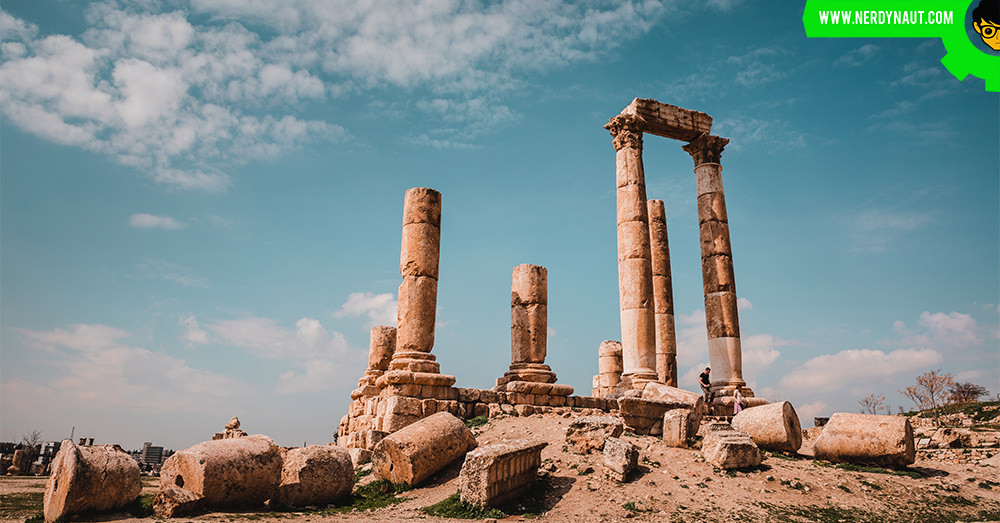
Jordan is a country that boasts of its rich culture, heritage and history that dates back to the Bronze age. One of Jordan’s most reputed historic cities without doubt would be ‘Petra’, the rock carved humongous palace. Thousands of Tourists flock over to this world wonder site each year. However Petra is not the only mesmerizing historic destination in Jordan. There are countless stories hidden within the hustle bustle city of Amman.
Amman – the Capital – of Jordan is usually a busy town like any other capital city in the world with local stores, traditional eateries and shopping hubs. But the city also is home to numerous ancient ruins. In fact, towering above the city on a hill is the Amman Citadel. This enthralling site comprises a 1700 meter Bronze Age wall that conveniently holds magnificent structures within its grasp.
The Amman Citadel
The Citadel area was home to many ancient inhabitants including Babylonians, Persians and Greeks. Located 850 meters above sea level, the Citadel site stands on top of the Jabal Al Qala’a, a massive hill. This place was initially known as Rabbath Ammon which translated as the royal ancient city of the Ammonites of those who lived in the kingdom during the Iron Age. The citadel is believed to be built back in 1800 BC and has gone through many changes during Byzantine and Roman periods, untimely destructions and has been rebuilt many times since then. Hence why this Bronze Age Citadel is a magnificent time portal that speaks of different Eras, their architectures and styles.
In this amazing Citadel, lies some of the most outstanding historic creations which you should consider visiting if you’re planning to travel to Jordan sometime.
The Temple of Hercules
This unique temple was built by the Romans back in 160 CE. Today only a few structures remain of the great temple. The most iconic site of the temple is the mesmerizing hand which is believed to be a part of the statue of Hercules. The hand is all what remains of the statue. The temple also include two complete pillars which are 30 feet high and ruins of four other pillars. Archeologists believe that the temple would have reached 13 meters in height originally. According to an inscription the temple was built when Geminius Marcianus was governor of the Province of Arabia.
What happened to the rest of the ruins? Many believe the statue of Hercules toppled during one of the area’s periodic catastrophic earthquakes, the statue fell to bits. Only the hand and the elbow lived through to tell us a story.
The Umayyad Palace
The Umayyad Caliphate was the second of the four major caliphates established following the death of Prophet Muhammad. The caliphate was ruled by the Umayyad dynasty, originating from Mecca.
Built by the powerful Umayyad dynasty between 7th and 8th century, the Palace itself is a large splendid complex spreading over the northern side of the hill of the Citadel. Back in the day, archeologists believe that this site would have possessed quite a few buildings in addition, but today we only see the Palace as the rest were destroyed by – yet another – Earthquake. Within the Umayyad complex, contains the ruins of residential buildings and the Cistern which was used to transport water to the palace.
Beyond the entrance hall of the Palace is the second largest plaza, from which the colonnaded street leads ahead. This was said to be the heart of the administrative quarter, surrounded by nine separate residential buildings. At the far end of the street would be the third plaza also the private residential quarters of Amman’s ruler. This room is dominated by an audience room which leads through to a domed, throne room. It is believed that the ruler would stay hidden behind the curtain during audiences.
Byzantine Church
This ancient Byzantine church was built in 550 AD and has a basilica plan that consists of a central nave and two side aisles. The original semi-circular apse in the eastern end of the building separates from the church by a chancel screen. Archeologists believe the rectangular rooms which complete the isles may have been constructed by the Umayyads. The church would’ve been a wonderful masterpiece of architecture that boasts of the Byzantine Heritage, but due to earthquakes, almost all of this construction has fallen to the ground. What remains today is the nave has a mosaic floor which is a common feature in the Byzantine period. Even it is now covered over for protection.
Jordan Archaeological Museum
Located in the Amman Citadel, the Jordan Archeological Museum preserves a rich collection of artifacts which dates back to the ancient Bronze Age and the Paleolithic age to the Islamic Era. Built in 1951, this location was chosen to express the fusion of cultures of Roman, Byzantine and Arabic heritage. Some of the highlights still on view are Statues from Ain Ghazal, among the earliest known large-scale human figures which are said to be almost 8700 – 8500 years old Neolithic plastered skulls from Jericho, Iron Age sarcophagus which were found in Amman and the white marble bust of the protector of Roman Philadelphia.
Apart from historic artifacts, the museum is also home to fine jewellery of the day, and magnificent statues as well.
The city of Amman, is not only for the city lovers nor history enthusiasts. It’s for any person craving for adventure. There is so much to experience such as new cultures, exotic heritage, architectural advancements back in the day and mostly the sunset views from the top of the Citadel hill. Remember to head over to the Amman Citadel to experience all the highlights of Jordan.




